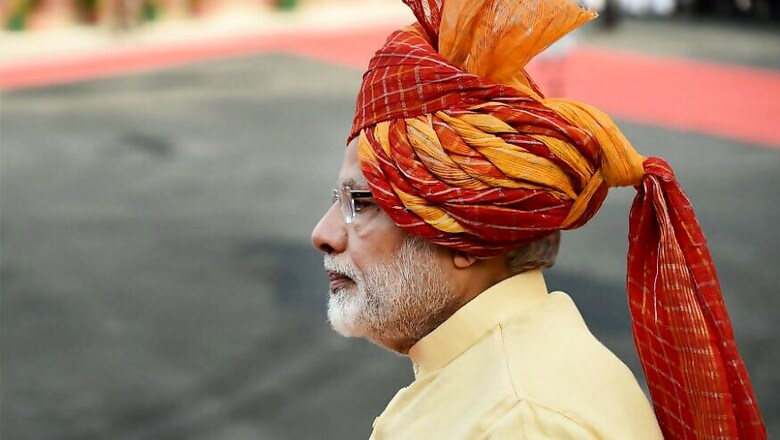
views
Once upon a time, Narendra Modi needled Rahul Gandhi for being the most lampooned politician on the internet. Six months later, he shares that doubtful pleasure.
If humour speaks truth to power, the collective guffawing over social media jokes on taxation and achhe din is a wake-up call for the BJP, even as it shifts into electoral gear for Lok Sabha 2019.
Dissonance on the state of the Indian economy — notably GST, demonetisation, job crunch, fuel price hike and the exacerbated agrarian crisis — has put an end to the NDA’s extended honeymoon with the middle-income classes.
The public discourse has shifted from celebration of Prime Minister Narendra Modi’s capacity for bold policy initiatives and vigorous nationalism to a sharp critique of his government’s ineptitude on the finance front and low capacity for implementation of schemes.
Of greater significance to the BJP than the firestorm of creative internet humour and sniping by a languid opposition, is the assay of its performance by the Sangh Parivar.
In a recent meeting at Vrindavan, attended by BJP president Amit Shah and other party luminaries, frontal organisations affiliated to the RSS underlined the adverse impact of demonetisation and GST on the farm sector, small businesses and jobs in both the organised and unorganised sectors, as well as the negative grassroots feedback.
The comparison with ‘India Shining’ of 2004 is irresistible. Then, as now, the RSS confronted the NDA government on policy issues, a popular prime minister stood head and shoulders over an unpopular government and the aam aadmi’s simmering discontent went unnoticed by BJP election managers.
That said, the dramatis personae are very different. The opposition is far weaker and the ruling conglomerate much stronger. More to the point, Modi is not Vajpayee and Rahul is not Sonia. And the RSS is far more invested in the continuance of the government.
Looking at the pre-electoral scenario by numbers, the BJP enjoys hegemonistic domination of the north, centre and west. But its presence in the south and east, apart from Assam and Karnataka, is marginal.
Given that it faces anti-incumbency in a number of states, can it compensate for the inevitable losses in the Hindi belt by breaking new ground?
In 2016, the NDA received unprecedented vote share of 15 per cent in Kerala and 10.7 per cent in West Bengal (an increment of 6 per cent).
The pace of progress may be too slow to make an impact in 2019, but it must be borne in mind that in a first-past-the-post system, even a small augmentation in vote share can translate into a disproportionate number of seats. In 2014, the BJP won 282 seats with a 30 per cent vote share, whereas the Congress won just 197 with 40 per cent in 1989.
In vote-bank terms, the BJP’s deft social engineering and strategic alliances have certainly made inroads among the Dalits and OBCs, both upper and lower. On the other hand, it stands to lose — for the very first time — its core vote bank. The trading community, which backed the BJP to a man in 2014, appears to have turned against the party with a vengeance. Rage against the tax ‘raj’ is ubiquitous.
As a senior RSS functionary points out, the government’s war on corruption has disrupted the ‘clean’ cash economy instead of curbing black money. Added to this is disturbing feedback from the business community of alleged rampant corruption in the Income Tax department and other regulatory agencies.
The prolonged agitation by farmers in Sikar, Rajasthan, was distinctive in that it involved traders. The farmer-trader-worker combine, beyond caste, class and party affiliations, represents the biggest challenge yet to the BJP.
In this season of discontent, come rumours of a split within the ruling dispensation, between party and government, as economic policy comes into conflict with electoral compulsions.
While law and order is a state subject, the failure of BJP-ruled state governments to handle public unrest and vigilantism will doubtlessly be laid at the party’s door. For instance, the inept, or rather suspect, handling of the Dera Sacha Sauda violence in Haryana, the Pehlu Khan murder in Rajasthan and the agitation at the Banaras Hindu University (BHU).
To be fair, the Karnataka government has been no less maladroit in dealing with the murder of activist MM Kalburgi (said to be linked with that of Gauri Lankesh).
On the flip side, the BJP enjoys the advantages of a charismatic PM, a proactive party president, a weak opposition and a slew of populist schemes which are likely to come to fruition in the next one year.
Modi is adept at recouping his popularity with just one public address and has established a direct connect with voters, as even Rahul Gandhi has admitted.
His Mann ki Baat radio show, which consciously pitches the narrative at the ground level, is said to have 27 crore listeners.
Leveraging the PM’s popularity is party president Amit Shah, whose electoral strategy works at the macro and micro-level, i.e., at the level of the state and the constituency. He deploys both social media and grassroots level contact for aggressive outreach. A seat-by-seat analysis has revealed 120 critical constituencies, which have come in for special attention. Shah himself is tireless and is relentless in driving his troops.
Economic setbacks have overshadowed the NDA government’s attempts to improve public delivery systems.
Among its more creditable efforts is the Ujjwala Yojana, whereby some 3 crore subsidised cooking gas connections have been given to rural households. The programme was preceded by the GiveItUp campaign, which used — for the first time — philanthropy as a public policy tool.
Then there’s the Ujala Yojana, which popularised energy-saving devices and fuelled the growth of the LED industry — one of the few job creators in recent times.
Perhaps the best known initiative is the Jan Dhan Yojana, which opened 30 crore new bank accounts and enabled direct benefit transfer of subsidies, resulting in — according to the government — a Rs 50,000 crore saving to the exchequer.
Further savings have been effected through the Government e-Marketplace (GEM) — an Amazon-style online portal for purchase of goods and services by government agencies, which has eliminated middlemen and instituted transparency.
Not even the severest critics of the government can deny that mandatory neem coating of urea has brought down fertilizer consumption by farmers and helped curb illegal diversion to industry.
Likewise, healthcare consumers will attest to the fact that the e-hospital initiative has made access to treatment at AIIMS and some other government hospitals easier. And at least a handful of rail passengers have found relief through the Indian Railways’ Twitter sewa!
Other schemes like the venture capital funds for Dalits, participatory governance, crop insurance, Swachh Bharat etc have been less successful. However, foreign policy has been a win-win area and most voters will still see the prime minister as best suited to safeguard national security.
But the BJP’s main advantage could be a disunited opposition. Reduced to a rump, the Congress is no longer the natural centre of gravity it was in 2004. Nor does Rahul enjoy the trust that regional chieftains repose in Sonia Gandhi. Besides, the split in anti-BJP forces in Bihar and Uttar Pradesh has been a serious setback for the opposition as a whole — because Lok Sabha 2019 is shaping up to be a contest of alliances.
At this point, with elections 18 months away, it can safely be said that, barring force majeure, the NDA will need bold strategic moves to hold on to its majority. Or (to cite a recent post), “ab ki baar” it might be “rehne de yaar”.
(The writer is a senior journalist. Views are personal)















Comments
0 comment